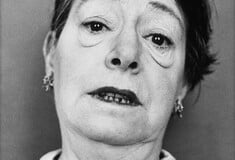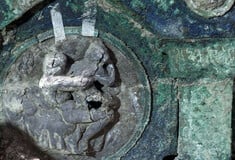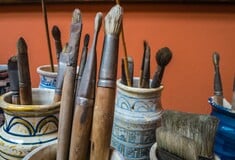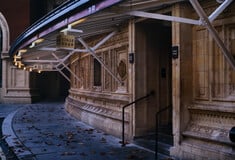Ο καλλιτεχνικός διευθυντής της Gucci, Alessandro Michele είχε μία καλαίσθητη πρόταση για τον λογαριασμό θεμάτων ομορφιάς του οίκου στο Instagram
Ο οίκος Gucci παρουσίασε χθες ένα νέο λογαριασμό Instagram, τον @ guccibeauty, όπου συναντιούνται δημιουργικά η ομορφιά με την ιστορία της Τέχνης του Πολιτισμού.
Οι αναρτήσεις του συγκεκριμένου λογαριασμού είναι μαθήματα Τέχνης για αρχαρίους, ενώ με ένα γρήγορο σκρολάρισμα ο αναγνώστης αισθάνεται να έχει βγει από ένα φανταστικό μουσείο.
View this post on Instagram
Title: Mummy Portrait: Head of a Woman, Egyptian, 130-160 AD (encaustic with gilded stucco on wood) Museum: Detroit Institute of Arts, Detroit ⠀⠀⠀⠀⠀⠀⠀⠀⠀⠀⠀ Egyptian Fayum mummy portraits, created mainly within the Faiyum Basin of the West Side of the Nile, were directly influenced by the Roman occupation of Egypt. The portraits largely belonged to upper class Egyptian citizens — including military, civil servants, and religious dignitaries — who adopted facets of the dominant Greco-Roman culture through hairstyles, clothing, and accessories. This c. 130 A.D. portrait from the @diadetroit is a perfect depiction of the style of portrait, featuring ornamental jewelry; a three-dimensional use of light and shadows to mimic the subject’s creamy skin tone; and large, expressive eyes capturing the steady attention of the viewer. #GucciBeauty — @britticisms Detroit Institute of Arts, USA / Gift of Julius H. Haass / Bridgeman Images
A post shared by Gucci Beauty (@guccibeauty) on Sep 14, 2018 at 10:09am PDT
View this post on Instagram
Title: Portrait of a young woman with a gilded wreath, A.D. 120–140 Museum: Metropolitan Museum of Art, New York ⠀⠀⠀⠀⠀⠀⠀⠀⠀⠀⠀ The distinct appearances and encaustic technique (a mixture of wax and pigment) used by the ancient Egyptian mummy painters helped preserve the colors and details of each portrait for more than 2000 years. Created mainly within the Faiyum Basin, a region on the West Side of the Nile, during the Roman occupation of Egypt, the portraits mimic the aesthetic of Greco-Roman panel paintings from the same era. In this portrait, the painter also added gold leaf to the encaustic on the woman’s wreath and lunula, a gold chain necklace with a crescent, to highlight the creamy texture of her skin and the flushes of pink across her cheeks and nose. #GucciBeauty #TheMet — @britticisms Rogers Fund, 1909
A post shared by Gucci Beauty (@guccibeauty) on Sep 14, 2018 at 10:09am PDT
Τα πρώτα 24 posts προβάλλουν κυριολεκτικά μια εκλεκτική επιλογή από την παγκόσμια ιστορία της Τέχνης: από τις περίτεχνες ελαιογραφίες ανώνυμων Ευρωπαίων καλλιτεχνών μέχρι τα απίστευτα ολοζώντανα πορτρέτα του Φαγιούμ.
View this post on Instagram
Title: Woman Shaving her Nape, 1897 Author: Toyohara (Yōshū) Chikanobu, Akiyama Buemon Museum: LACMA, Los Angeles ⠀⠀⠀⠀⠀⠀⠀⠀⠀⠀⠀ The 19th-century Japanese artist Yoshu Chikanobu made multiple series of traditional woodblock prints focusing on beautiful women, the genre of bijinga, with names like “True Beauties”. The portraits represent the male gaze, but this image of a woman rearranging her hair in a casual, self-aware pose demonstrates an awareness of the labor involved in maintaining beauty, particularly in a culture where women are often expected to be passive. The outlines and soft colors of such woodblock prints also influenced the Impressionists, like the American Mary Cassatt. This image is in the collection of @LACMA, one of the #GucciPlaces. #GucciBeauty — @kchayka Image courtesy of LACMA
A post shared by Gucci Beauty (@guccibeauty) on Sep 14, 2018 at 10:10am PDT
Κάθε ανάρτηση συνοδεύεται από μια σύντομη περιγραφή καλλιτεχνών και κριτικών, ενώ στις λεζάντες μπορεί κανείς βρει λίγες περισσότερες πληροφορίες για το χρονικό πλαίσιο, κατά το οποίο προέκυψε το καθένα από τα έργα τέχνης.
View this post on Instagram
Title: Woman at her toilet, c.1700 Author: François Boucher Private Collection ⠀⠀⠀⠀⠀⠀⠀⠀⠀⠀⠀ ⠀⠀ ⠀ ⠀⠀ ⠀ ⠀⠀⠀⠀⠀⠀⠀⠀⠀⠀⠀ François Boucher was one of the defining artists of France’s Rococo period, known for his voluptuous, romantic paintings depicting allegories and genre scenes. In particular, his paintings often have a kind of eroticism, emphasized by his soft rendering of flesh amid idyllic landscapes. In this 18th-century portrait of a woman at her toilet, Boucher depicts a rosy-cheeked woman gazing at herself in the mirror; her hands in particular have a plump sensuality. A lover is suggested by the portrait she holds in her hand, giving her placid, thoughtful expression a romantic feeling. #GucciBeauty — @lrsphm Photo © Agnew's, London / Bridgeman Images
A post shared by Gucci Beauty (@guccibeauty) on Sep 14, 2018 at 10:09am PDT
Ας σημειωθεί ότι αυτός ο εμπνευσμένος λογαριασμός στο Instagram είναι πνευματικό παιδί του δημιουργικού διευθυντή της Gucci, Alessandro Michele, και θα αποτελεί επίσης το διαδικτυακό σημείο στο οποίο η Gucci θα παρουσιάζει νέα προϊόντα ομορφιάς, τάσεις, παρουσιάσεις μόδας και ειδικές συνεργασίες.
View this post on Instagram
Title: Federico Gonzaga, 1510 Author: Francesco Francia Museum: Metropolitan Museum of Art, New York ⠀⠀⠀⠀⠀⠀⠀⠀⠀⠀⠀ Francesco Francia, a painter from Bologna, created this 1510 commission for Marchesa Isabella D’Este. It is a portrait of her son, Federico II Gonzaga, who would go on to rule the city of Mantua. The piece from the @metmuseum displays Francia’s trademark affinity for lush coloring and flattering, rounded figuration, which made him one of the more sought-after portrait painters of his time. The young boy is depicted with a soft, androgynous beauty; a light smile, rosy cheeks, and gold-embroidered attire fit for any royal heir. #GucciBeauty #TheMet— @sirsargent Bequest of Benjamin Altman, 1913
A post shared by Gucci Beauty (@guccibeauty) on Sep 14, 2018 at 10:10am PDT





























σχόλια